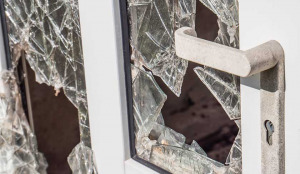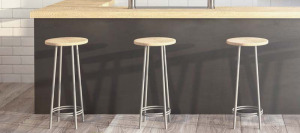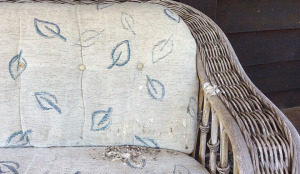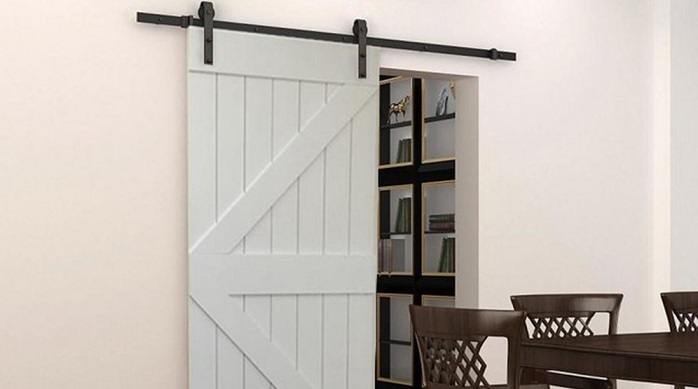Does your bathroom need a freshen up? In this complete DIY guide we explain how to paint bathrooms properly, with special attention to the unique needs of these humid wet rooms.
Unlike our living room or bedroom, often we neglect painting the bathroom until it’s already well overdue. That’s no surprise since we probably don’t spend as much time in them lazily staring at the walls. Also, compared with other rooms, bathrooms seem much more complicated to paint.
Bathrooms are humid, mold-prone environments and painting them may seem like a bit of a science experiment, trying work out what paint properties you need to ensure moisture and mold don’t ruin your paint work. That’s why we’ve decided to focus this entire article on just explaining how to paint bathrooms.
In this article we provide you with a hands-on guide for how to paint bathrooms that you can follow step-by-step, to get your wet room looking fresh again.

Best Bathroom Paint Finish and Paint Type
Buying paint for your bathroom is probably going to be your first step. So, before we get started learning the techniques for how to paint bathrooms, let’s discuss the best bathroom paint finish and best type of paint in bathroom including walls, ceiling, tiles and vanities to ensure you buy the right paint.
What are the best paint finishes for bathroom?
In your bathroom the paint finishes you can go with are, well, any really – satin, glossy or semi-glossy finish paints are all fine. The best paint finishes for your bathroom depend on your taste, whether you like it glossy or not. I personally don’t like glossy paint on any walls, but that’s my preference.
However, regardless of the paint finish you choose it is important to make sure that the bathroom paint you choose is mold and mildew-resistant in any case. This is to ensure that humidity will not promote the growth of these organisms on your paint.
It is also better to choose a self-priming variety of bathroom paint so that you do not have to perform that step separately. The hardware store will have a dedicated section for bathroom paints, and from there you can then narrow down your options to find the mold/mildew resistant and self-priming types in the paint finish you prefer.
But first, before ordering that paint, make a list of the surfaces you want to paint in your bathroom.
Wondering why we are asking you to do so?
Unlike your living room or bedroom, your bathroom is made up of a variety of different surfaces. Depending on your bathroom design and which areas you are planning to paint, this could include your walls, vanity, ceiling, window sills, shelves, mirror frames and even tiles. And for each of these different surfaces it makes sense to use a different type of paint.
If you are working to a strict budget, have a look at our article on calculating DIY paint cost and coverage here to help you estimate the paint area and cost accurately.
Next, we’ll go over which type of paint to use in specific bathroom areas and surfaces.
What type of paint in bathroom walls?
As discussed earlier, regardless of the bathroom paint finish you choose, you need to go with a mold and mildew-resistant interior paint for the bathroom walls. Depending on the interior ambiance you want to achieve, you can choose between different paint finishes for your bathroom like matte, glossy, or semi-glossy.
Also, if it is self-priming, it will undoubtedly reduce your work and make it easy to paint the bathroom yourself. Sure, such paint will set you back by a fair amount, but it is worth it in the longer run.
What type of paint in bathroom ceiling?
Most people will advise you to use epoxy paint type for the bathroom ceiling. However, unless and until it’s a commercial bathroom, going with an epoxy type of paint in your bathroom will be overkill. Moreover, it is quite expensive for personal use.
A much better option is emulsion-based bathroom paints like latex paint. They should be of the water-based type to resist moisture. Such bathroom paints are often mold and mildew resistant, which like with bathroom walls, is a quality you should look for when choosing your bathroom ceiling paint. Even with consistent exposure to moisture, these organisms will not grow on the paint.
The bathroom ceiling has to handle a lot of moisture because the steam from the hot shower always moves up. You have to choose a paint for the bathroom ceiling that can handle high temperatures, is resistant to moisture, and resists the growth of mold and mildew.
The emulsion-based acrylic latex paint, which is water-based, meets all of these requirements.
What bathroom paint types for tiles?
For the bathroom tiles, you can buy specific tile paints. They stick to the tiles pretty well and are washable as well. While epoxy type paints are suitable for bathroom tiles, it makes sense to stick to usual tile paints unless it is a commercial bathroom. You can also buy grout paint, if you want to go ahead and paint the grout on your bathroom tiles a different color as well.
What bathroom paint types for vanities?
Latex-type paints suit bathroom vanities as well. These paint types are often water-based and do not result in odor. Latex paint is also easier to clean, so your bathroom vanity will look as good as new for years to come.
How to Paint Bathrooms | Checklist
We’ll go over each of these steps in detail in the next sections, but here is a checklist of the steps for how to paint the bathroom, including prep and paint.
Part 1: How to Prepare to Paint Bathrooms
- Step 1: Procure your bathroom painting supplies
- Step 2: Cover the bathroom floor
- Step 3: Clean the bathroom surfaces
- Step 4: Patch any holes
Part 2: How to Paint Bathrooms
- Step 1: Remove the toilet tank
- Step 2: Remove other obstructions
- Step 3: Prepare the paint
- Step 4: Cut in the paint on the ceiling
- Step 5: Continue with the trim
- Step 6: Paint the edges with an angled brush
- Step 7: Use a roller for the rest
- Step 8: Let it dry for 4 hours
- Step 9: Apply the second coat
- Step 10: Reinstall the fittings after 24 hours
How to Paint Bathrooms | Preparation
Once you are sure about the type of paint you need, you cannot start painting the bathroom right away. There are a few steps you need to follow to prepare the bathroom before we delve into the steps for how to paint bathrooms.
1. Procure your bathroom painting supplies
The first thing you need to do is procure the supplies. These may include:
- Paint roller
- Water-based paints (and primer if required)
- Paint tray
- Pan liner
- Drop cloths and/or plastic sheet for covering surfaces
- Step ladder
- Painter’s tape
- Extension pole
We cover painting equipment in detail in our article on how to paint the interior of a home; the equipment for painting a bathroom is the same. If you need help choosing your equipment and understanding what the different tools do, then jump over to that article.
Once you get your bathroom painting tools and equipment, you can move on to the next step.
2. Cover the bathroom floor
While you might paint every bathroom surface, you surely won’t be painting the bathroom floor. That is why it is essential to cover the floor properly.
With the help of drop cloths or plastic sheets, you can cover the floor. However, instead of just laying them on the bathroom floor, make sure that you use the tape to keep it in place. Similarly, the other surfaces you do not want to paint, like the sink and bathtub, should be covered with plastic sheets.
In case there is any part of the trim which you do not want to paint over, cover it with painting tape. Once you do so, you can paint with ease, knowing that paint won’t stain any of these surfaces.

3. Clean the bathroom surfaces
After that, you’re now left with the surfaces you want to paint. However, directly applying the paint is not a good idea. Over time, mold, grime, soap, dust and other residue accumulate on bathroom surfaces. That is why you have to clean the bathroom surfaces before painting. Yes, it is unpleasant, but necessary.
For cleaning them, you can use soap to remove any kind of residue. You can also use a mixture of vinegar, water, and baking soda. The choice is yours. If you need to remove mold, select a suitable mold and mildew cleaner from your local hardware store and follow the instructions.
Step 3: Patch any holes
Over time due to wear and tear, there might be holes in ceiling or walls. If you notice any, you must fill them up with drywall compound (aka spackle). If you do not have any, you can also use wood filler. Follow the instructions on the label. After filling, allow it to dry fully then use fine sandpaper to level it out, to ensure a smooth surface. Remember to wipe the patched areas with a dry clean cloth, to remove any sandpaper or filler residue before painting.
Now that you have removed all the grime and contaminants from the walls, and patched up any holes, let’s get into how to paint bathrooms in 10 easy steps.
How to Paint Bathrooms | 10 Step Guide
Below is the step-by-step guide you need to follow to paint the bathroom from start to end. In these ten simple steps, you can paint the walls and ceiling of your bathroom. Since these days self-priming paints are available, you need not prime the walls separately unless you specifically chose a separate paint and primer.
Remember to follow the preparation steps before you begin, including washing the walls and laying down plastic sheets. Also, have all your equipment laid out and ready to go.
Step 1: Remove the toilet tank
The first thing you need to do is remove the toilet as it is very difficult to reach the area behind the toilet with the help of a roller. However, before that, make sure to turn off the water supply.
Step 2: Remove other obstructions
Apart from the toilet tank, it is good to remove bath products, wall hangings, light shades and electrical appliances from the bathroom.
If you are going to paint the vanity, cover it for the time being with plastic sheets, as we will be painting it separately. Even if you’re using the same paint color and finish for the vanity, drips can show up as unattractive bumps and bulges in your finished paintwork once you do get around to painting the vanity, so you should cover it for now.
Step 3: Prepare the paint
The next step is to stir the paint very well with a paint stirrer, clean stick or a long-handled flat head screwdriver, until it is properly mixed together with a uniform color and no separation. Remember to wipe the screwdriver off right away, so you don’t ruin it with dried paint. Pour the paint into the painting tray for your roller, leaving the rolling area free of paint.
Step 4: Cut in the paint on the bathroom ceiling

When painting the bathroom, we start with the ceiling. How to paint the bathrooms ceiling:
Part 1: Paint ceiling edges with brush
Whenever you want to paint the walls and ceiling of a certain area, you have to always start with the ceiling. For the best finish, start painting around the ceiling edges. Instead of using a roller for the edges, using a good quality paintbrush like one of these will give a better finish. Pour some paint into a cup or mug you can hold easily in one hand, grab your paintbrush and a stepladder. Be patient, relax and keep a steady hand while painting the edges of the ceiling. Music helps me get in a relaxed, focused mood while painting. Don’t rush, or you’ll make mistakes.
Part 2: Paint ceiling surface with roller
After the edges are done, attach the roller to the roller holder, and attach it to the extension pole. Dip the roller in the paint and drip off the excess paint. Now you can start cutting in. The process of cutting in involves painting in proper lines rather than in a haphazard manner. The roller should be used for the large flat areas of the ceiling rather than the edges.
Step 5: Continue with the trim
After the ceiling is done, you have to paint the trim along the walls, if any. To do this, use a brush. If you plan to use a separate color or paint for painting the walls, you might have to prepare it again in the painting tray. I suggest buying enough trays and rollers for all your different colors and types of paint, so you don’t have to mess around with cleaning the roller and tray between paints.
Step 6: Paint the edges with an angled brush
After that, continue painting the edges of the walls with the help of an angled brush. Again, pour some paint into a cup or mug and hold this in one hand as you go along – much easier than dipping into a bucket or roller tray every time.
Some people say the brush should be used to paint about half an inch from the edge. I personally find this to be too narrow. I prefer to go much wider, maybe 1-2 inches, so there is no risk of the roller accidentally hitting the wrong area.
Step 7: Use a roller to paint the rest of the bathroom walls
The other areas of the bathroom, that is, the walls, should be painted with a roller. Even though the walls might be easily accessible, but it is a good idea to use the extension pole so that you can access the entirety of the wall without much effort.
Step 8: Let the bathroom paint dry for 4 hours
With the application of the first coat over, you should wait for at least 4 hours. However, some paint types require you to wait up to 24 hours. The drying and waiting time of 24 hours is pretty common for oil-based paints.
On the other hand, some paints may have a shorter wait time on the first coat. It is good to look at the instructions on the paint can. Only then will you know the exact time you have to wait.
Step 9: Apply the second coat of paint to bathroom ceiling and walls
You then repeat the same procedure (Steps 4-7) for applying the second coat. Applying the second coat is necessary as the first coat might not cover the walls and the ceiling uniformly, and often ends up looking patchy and uneven.
Step 10: Reinstall the fittings after 24 hours
Now that the second coat is over, you might be thinking about when you can reinstall all the fittings, including the toilet bowl.
The answer to this question is at least after 24 hours. Installing the fittings before 24 hours might negatively affect the paint finish, with unwanted scuffs and such – better to wait.
That’s it!
How to Paint Bathroom Vanities
There are essentially five steps for how to paint bathroom vanities, using much the same painting techniques as earlier. As you will see, the steps for painting a bathroom vanity are much easier than the walls and the ceiling.
Step 1: Prepare the bathroom vanity for painting
The very first step is prepping the bathroom vanity. Here are the basic steps for how to prepare the bathroom vanity for painting:
- Cover all the surfaces you do not want to paint with plastic sheets, then tape down the plastic sheets.
- Remove all the personal hygiene items, cosmetics, and so on from the bathroom vanity.
- Detach the hardware like knobs, hinges, and so on.
- Remove the cabinet doors and drawers, especially if you do not want to paint them. If you do want to paint them, it is up to you whether to paint them while they are on or off (I would personally take them off and paint them separately).
- Clean the remaining surfaces of your bathroom vanity that will be painted. In most cases, you can use water and soap to clean the vanity surfaces.
Note: Some bathroom vanities may need specific cleaning supplies; if you are uncertain look up the specifications for your vanity to see what material it is made from and then follow the cleaning instructions for that type of material. For example, particleboard will expand if exposed to too much water, so if your bathroom vanity is constructed of particleboard (aka chipboard) you will need to limit your water-usage while cleaning the vanity, before painting.
Step 2: Patch up and sand the bathroom vanity
Before you paint the vanity, it is time to patch the holes. For this, it is best to find a filler (aka spackle) that is best suited to your vanity construction material. In most cases you can use a wood filler or wooden putty. After you have used a filler to patch up holes in the bathroom vanity and allowed it to dry fully, you can then use sandpaper to smooth and level it out.
Step 3: Protect areas that should not be painted
Apply the painter’s tape on any area of the vanity which you do not want to paint. If there are larger areas, you can cover them with plastic sheeting. If the areas are too small for a plastic sheet but too large for covering with tape, for example the sink and taps, you can cover them with a piece of cardboard or plastic bag which has been secured down with tape.
Step 4: Paint the bathroom vanity
Now, we come to actually painting the vanity. Here are the basic steps for how to paint bathroom vanities:
- Paint the frame: Start with the vanity frame first. Use a roller to apply the paint to the vanity frame.
- Paint the doors, drawers etc: After painting the vanity frame, move onto the vanity doors, drawers, and corners. These areas are a bit trickier, and may require a brush or a mini-roller.
- Allow to dry: Usually, a single layer of paint is good enough for the vanity but if you want to apply the second coat, make sure you wait for the designated time before applying the second layer.
- Apply second coat: Apply a second coat of paint, as instructed above. The second layer will give more finesse to the vanity appearance.
Step 5: Reassemble the vanity
You should attempt to reassemble the vanity only twenty-four hours after the last coat of paint. Allow the fresh paint on the bathroom vanity to dry fully before reattaching doors and handles, and putting back drawers and personal items.

How to Paint Wall Tiles | Bathroom
To paint the bathroom wall tiles, you need special paint, as discussed above in the section ‘What bathroom paint types for tiles?’ Once you have procured tile paint for the wall tiles, follow the steps below to paint wall tiles (bathroom).
Step 1: Clean the bathroom wall tiles
Similar to other surfaces of the bathroom, tiles also suffer from the accumulation of grime, soap, shampoo, dust and other contaminants. That is why always start by cleaning the tiles first, before you apply any paint in your bathroom whatsoever. You can use a commercial cleaner along with a sponge for cleaning the tiles. Make sure that you use the commercial cleaner and rinse it well with water before proceeding.

Step 2: Fill in cracks on the wall tiles
For painting any surface, it needs to be completely smooth to avoid unevenness in the paint coat. In case you notice any cracks in the bathroom wall tiles, you will have to fill that in.
For this, you can use caulk, but make sure it is suitable for bathroom and wet areas before using. To fill in the caulk, you can use a knife. Before you start applying the paint, make sure to wipe away excess caulk. Only when the caulk dries, which can take a couple of hours at least, can you proceed to the next step.
Step 3: Sand the surface of the bathroom wall tiles
Tiles usually have a layer of glaze over them. If this glaze layer is present, it becomes difficult to paint over it and have the paint adhere to the surface of the tile properly. Use 100 grit sandpaper for sanding the tiles, using a sanding block or electric sander. Once the sanding process is complete, use a damp cloth to wipe out any residue.
Step 4: Paint bathroom wall tiles
Finally, after proper preparation, here are the steps to paint bathroom wall tiles using a roller:
- Prepare your tools: Prepare and arrange your painting equipment (eg roller, roller tray, drop cloths) in the manner described above for painting walls and vanities.
- Prepare the paint: Mix the paint well, then pour the tile paint in the roller tray. The tile paint is usually much thicker than the paint for your bathroom walls.
- Apply paint with roller: Use a normal roller to apply it to the tiles.
- Allow to dry: Depending on the type of paint you are using, it can easily take 48 hours to dry. You won’t be able to use your bathroom till then. However, when you’re waiting for the tile paint to dry, do make sure that you keep the bathroom well ventilated. Only then, will it dry at a fast pace.
If you want the grout in your bathroom wall tiles painted as well, this is possible with grout paint. Specialty grout paints exist in various colors; just follow the instructions on the label to prepare and apply it properly.
Video Demonstration | How to Paint Bathrooms
While we have covered each step in writing, there is nothing better than actually seeing it in action. Here is a popular video showing how to paint the bathroom from Zac Builds on YouTube (thanks guys!)
Wrapping Up
Well, that pretty much wraps it up for our complete DIY guide on how to paint bathrooms. We have not only covered the type of paint you can use but also the exact step-by-step procedure to paint different parts of the bathroom. The steps for how to paint bathrooms as you can now see are not too different from painting other rooms in your house, the main difference being to make sure you clean the surfaces of any soap and grime very well before painting, and choose specialty bathroom paints that are self-priming, water-based and mold/mildew resistant. Now, you can have a gleaming bathroom by painting it on your own.
Author
-

Hey, I’m Sara, co-owner of NestKoo! I’m a graphic designer and professionally trained fine artist, with a Bachelor of Arts (Fine Art) majoring in Painting. I love being close to nature, sustainable living and bringing new life to old things. My specialty in NestKoo is DIY house painting, upholstery and furniture upcycling, where I bring my skills in fine art painting and contemporary design together into a practical home DIY context.
View all posts









